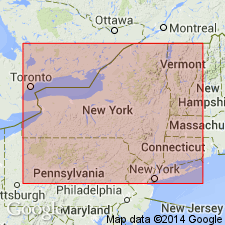
- Usage in publication:
-
- Gage Gully beds
- Modifications:
-
- Informally named
- Dominant lithology:
-
- Shale
- AAPG geologic province:
-
- Appalachian basin
Summary:
Windom Shale Member of Moscow Formation reaches a maximum thickness of 60 m in the eastern Finger Lakes area of NY. Here it consists of medium to dark gray fossiliferous mudstones and shales with thin concretionary limestone beds and can be divided into many informal traceable units and a number of thin, localized shell-rich beds. Unit 16, the highest strata of the Windom exposed in western NY, is here informally named Gage Gully beds for its maximum development along Gage Gully on the east side of Canandaigua Lake. In this area it consists of 5 to 6 m of dark gray to nearly black platy shale and is characterized by distinctive fauna that includes small specimens of AMBOCOELIA(?) NANA and the spiriferid brachiopod ALLANELLA TULLIUS. Small mollusks, gastropods, and the nautiloid SPYROCERAS are also abundant. In Genesee Valley to the west, the interval thins to 2 m and contains an abundance of trilobites and small mollusks. Eastward from its type locality, it thins and disappears in the Owasco Lake-Ithaca region, but reappears at Skaneateles Lake and thickens to 3 m in the Tully-Chenango Valley region where it is a slightly rusty and pyritic shale. Overlies the very thin Simpson Creek bed, which lies unconformably above the Spezzano Gully beds. Unconformably underlies either the Tully Formation or the younger Genesee Formation. (See Windom entry for complete lists of informal units.) Age is Middle Devonian (Givetian).
Source: GNU records (USGS DDS-6; Reston GNULEX).
For more information, please contact Nancy Stamm, Geologic Names Committee Secretary.
Asterisk (*) indicates published by U.S. Geological Survey authors.
"No current usage" (†) implies that a name has been abandoned or has fallen into disuse. Former usage and, if known, replacement name given in parentheses ( ).
Slash (/) indicates name conflicts with nomenclatural guidelines (CSN, 1933; ACSN, 1961, 1970; NACSN, 1983, 2005, 2021). May be explained within brackets ([ ]).

